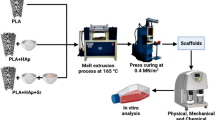Abstract
The cortical bone response towards poly(lactide-co-glycolide) (70/30) (PLGA) (70/30)/apatite complex scaffolds with different levels of crystallinity was investigated. Apatite with different levels of crystallinity, Ca-deficient hydroxyapatite (CDHA), which has a low crystallinity, and a mixture of carbonated hydroxyapatite (CHA) and CDHA, which has a higher crystallinity, were prepared from an aqueous mixture of Ca-EDTA complex, H2O2, H3PO4, and NH4OH. Two porous PLGA(70/30)/apatite composite scaffolds, composite scaffold A (containing low crystallinity CDHA) and composite scaffold B (containing the higher crystallinity CHA/CDHA mixture), were prepared. Afterwards, pure porous PLGA and the two composite scaffolds were implanted into the cortical bone of rabbit tibiae for 12 weeks. High-resolution microfocus X-ray computed tomography and histological examinations revealed a better bone response for composite scaffold A compared with PLGA and composite scaffold B. For composite scaffold A, the original bone defect was almost filled with new bone. Quantitative analysis revealed that composite scaffold A produced a significantly greater amount of new bone. The present study demonstrated that the level of apatite crystallinity influences bone response. A PLGA/apatite porous composite with a low level of apatite crystallinity shows promise as a bone substitute or scaffold material for bone tissue engineering.







Similar content being viewed by others
References
Wei G, Ma PX. Structure and properties of nano-hydroxyapatite/polymer composite scaffolds for bone tissue engineering. Biomaterials. 2004;25:4749–57. doi:10.1016/j.biomaterials.2003.12.005.
Watanabe T, Ban S, Ito T, Tsuruta S, Kawai T, Nakamura H. Biocompatibility of composite membrane consisting of oriented needle-like apatite and biodegradable copolymer with soft and hard tissues in rats. Dent Mater J. 2004;23:609–12.
Hasegawa S, Tamura J, Neo M, Goto K, Shikinami Y, Saito M, et al. In vivo evaluation of a porous hydroxyapatite/poly-DL-lactide composite for use as a bone substitute. J Biomed Mater Res. 2005;75A:567–79. doi:10.1002/jbm.a.30460.
Shikinami Y, Matsusue Y, Nakamura T. The complete process of bioresorption and bone replacement using devices made of forged composites of raw hydroxyapatite particles/poly l-lactide (F-u-HA/PLLA). Biomaterials. 2005;26:5542–51. doi:10.1016/j.biomaterials.2005.02.016.
Jayasuria JA, Assad M, Ebraheim NA, Jayatissa AH. Dissolution behavior of biomimetic minerals on 3D PLGA scaffold. Surf Coat Technol. 2006;200:6336–9. doi:10.1016/j.surfcoat.2005.11.032.
Kim SS, Sun PM, Jeon O, Cha YC, Kim BS. Accelerated bonelike apatite growth on porous polymer/ceramic composite scaffolds in vitro. Tissue Eng. 2006;12:2997–3006. doi:10.1089/ten.2006.12.2997.
Li L, Zhou X, Yongnian Y, Yunyu H, Renji Z, Wang SG. Porous morphology, porosity, mechanical properties of poly(alpha-hydroxy acid)-tricalcium phosphate composite scaffolds fabricated by low-temperature deposition. J Biomed Mater Res. 2007;82A:618–29. doi:10.1002/jbm.a.31177.
Simpson RL, Wiria FE, Amis AA, Chua CK, Leong KF, Hansen UN, et al. Development of a 95/5 poly(L-lactide-co-glycolide)/hydroxylapatite and β-tricalcium phosphate scaffold as bone replacement material via selective laser sintering. J Biomed Mater Res B Appl Biomater. 2008;84:17–25. doi:10.1002/jbm.b.30839.
Petricca SE, Marra KG, Numta PN. Chemical synthesis of poly(lactic-co-glycolic acid)/hydroxyapatite composites for orthopaedic applications. Acta Biomater. 2006;2:277–86. doi:10.1016/j.actbio.2005.12.004.
Mochizuki C, Sasaki Y, Hara H, Sato M, Hayakawa T, Fei Y, Xixue H, Hong S, Wang S. Crystallinity controlled apatites through a Ca-EDTA complex and their porous composites with PLGA. J Biomed Mater Res B Appl Biomater. 2009;90B:290–301.
Cai Q, Bei JZ, Luo AQ, Wang SG. Biodegradation behavior of poly(lactide-co-glycolide) induced by microorganisms. Polym Degrad Stab. 2001;71:243–51. doi:10.1016/S0141-3910(00)00153-1.
Shi GX, Cai Q, Wang CY, Lu N, Wang SG, Bei JZ. Fabrication and biocompatibility of cell scaffolds of poly(L-lactic acid) and poly(L-lactic-co-glycolic acid). Polym Adv Technol. 2002;13:227–323. doi:10.1002/pat.178.
Yang J, Bei J, Wang SG. Enhanced cell affinity of poly (D,L-lactide) by combining plasma treatment with collagen anchorage. Biomaterials. 2002;23:2607–14.
Tanimoto Y, Hayakawa T, Sakae T, Nemoto K. Characterization and bioactivity of tape-cast and sintered TCP Sheets. J Biomed Mater Res. 2006;76A:571–9. doi:10.1002/jbm.a.30558.
Donath K, Breuner GA. A method for the study of undecalcified bones and teeth with attached soft tissues. The Sage-Schliff (sawing and grinding) technique. J Oral Pathol. 1982;11:318–26. doi:10.1111/j.1600-0714.1982.tb00172.x.
Druncan C, Brown PW. Calcium-deficient hydroxyapatite-PLGA composites: mechanical and microstructural investigation. J Biomed Mater Res. 2000;51:726–34. doi:10.1002/1097-4636(20000915)51:4<726::AID-JBM22>3.0.CO;2-L.
Takahashi K, Hayakawa T, Yoshinari M, Hara H, Mochizuki C, Sato M, et al. Thin Solid Films. 2005;484:1–9. doi:10.1016/j.tsf.2004.12.052.
Hayakawa T, Takahashi K, Yoshinari M, Okada H, Yamamoto H, Sato M, et al. Trabecular bone response to titanium implants provided with a thin carbonate-containing apatite coating applied using molecular precursor method. Int J Oral Maxillofac Implants. 2006;21:851–8.
Hayakawa T, Takahashi K, Okada H, Yoshinari M, Hara H, Mochizuki C, et al. Effect of thin carbonate-containing apatite (CA) coating of titanium fiber mesh on trabecular bone response. J Mater Sci: Mater Med. 2008;19:2087–96. doi:10.1007/s10856-007-3293-1.
Masuda T, Yliheikkilä PK, Felton DA, Cooper LF. Generalizations regarding the process and phenomenon of osseointegration. Part I. In vivo studies. Int J Oral Maxillofac Implants. 1998;3:17–29.
Cooper LF, Masuda T, Yliheikkilä PK, Felton DA. Generalizations regarding the process and phenomenon of osseointegration. Part II. In vitro studies. Int J Oral Maxillofac Implants. 1998;13:163–74.
Oh S, Tobin E, Yang Y, Carnes DL, Ong JL. In vivo evaluation of hydroxyapatite coatings of different crystallinities. Int J Oral Maxillofac Implants. 2005;20:726–31.
Xue W, Liu X, Zheng X, Ding C. Effect of hydroxyapatite coating crystallinity on dissolution and osseointegration in vivo. J Biomed Mater Res. 2005;74A:553–61. doi:10.1002/jbm.a.30323.
Acknowledgement
This work was partly supported by a Grant-in-Aid for Scientific Research (C-19592260) from The Japan Society for the Promotion of Science, a Grant for Supporting Project for Strategic Research by the Ministry of Education, Culture, Sports, Science and Technology, 2008–2012, and with the support of the Major State Basic Research Development Program of China (No. 2005CB5227074). The authors are also grateful Assistant professor Hiroyuki Okada (Department of Oral Pathology, Nihon University School of Dentistry at Matsudo) for his help for histological observation.
Author information
Authors and Affiliations
Corresponding author
Rights and permissions
About this article
Cite this article
Hayakawa, T., Mochizuki, C., Hara, H. et al. In vivo evaluation of composites of PLGA and apatite with two different levels of crystallinity. J Mater Sci: Mater Med 21, 251–258 (2010). https://doi.org/10.1007/s10856-009-3830-1
Received:
Accepted:
Published:
Issue Date:
DOI: https://doi.org/10.1007/s10856-009-3830-1




